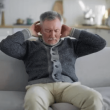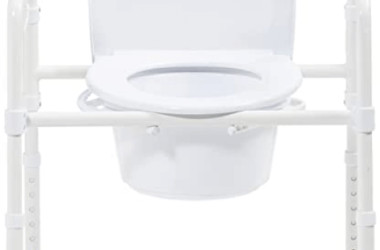To help an elderly person get up from the floor after a fall, the first thing to do is to check for possible injuries. If there are injuries call 911, if not follow the step-by-step guide below.
This article will help you Learn what to do when you are in this situation as senior or as someone assisting an elderly.
So, here is the topics you will be familiar with:
- 1.How to check for Injuries after the fall
- 2.How to help the elderly get up from the floor
- 3.Teach the elderly how to Get Up after a fall independently
- 4.Prepare and prevent (Phone Accessibility, etc.)
- 5.Devices around the topic of fall.

1. How to check if your elderly have injuries after the fall ?
When someone, especially an older person, takes a spill, the first thing on our minds is making sure they’re okay? and checking for any injuries.
The main goal is to keep them safe, and if things seem serious, calling 911 is a must.
Now, let’s take a closer look at how we can do a thorough assessment:
- Start with a Gentle Limb Rotation: Encourage the person to slowly move their feet, hands, and arms. This helps us spot any signs of pain or discomfort that could signal an injury.
- Lift the Hip and Neck: Gently lift the hip and neck to see if there are any hidden injuries. It’s a delicate move, and if there’s any pain during this, it’s important to stop right away and get professional medical help.<:LI>
2. Assisting the Elderly in Getting Up from the Floor :
Understanding the proper technique for assisting an elderly person in getting up from the floor is crucial to prevent further injury. It is important to remember that your role is not to lift their weight but to provide steady and supportive assistance.
Why ?
Because there is a high risk of injury for both of you if you fail to support his weight.
To help the elderly get up from the floor when he’s laying on his back, you will need to do some actions ( to do slowly ):
- Encourage Knee Bending: Start by encouraging the person to bend their knees, which establishes a base for the next steps.
- Placing Hands: Position their hand (left hand if they are rising from the side and vice versa) on their belly. Simultaneously place one hand on their hips and the other on the shoulder.
- Gentle Side Push: Ask them to roll onto the side from which they wish to stand up while providing a push to assist with movement.
- Adjusting Leg Position: Guide them in bringing their leg out in front of the bottom leg promoting a more controlled transition.
- Supporting Hands: Place your hand under their shoulder so that they can pull out their arms and rest on their hands.
- Transitioning to Hands and Knees: Move your hands to support their hips as you help lift them into a hands and knees position.
- Crawl to Furniture: Guide them to crawl close to a sturdy, secure piece of furniture. Ensure they place their hands on it for additional support.
- Assist in Standing: Help them pull their knee forward and place their foot directly under the knee, utilizing their strongest leg.
- Lift to Stand: Come around to the other side of the senior. Lift them to stand by hooking one arm under their arm and placing your other hand on their back.
- Encourage Forward Movement: Remind them to lean forward while pushing up with the bent leg and both arms.
- Stability Check: Once standing, ensure they are steady and not dizzy. Guide them to slowly turn and sit if needed.
You can look at this video to see how to help get up from fall :
3. Teach the elderly how to Get Up after a fall when he is alone
What if this happened and you are not there ? How does your elderly will get up alone in this case ? It will be hard and for some seniors impossible to get up if they don’t follow this strategy to get up after fall, learn them how to do:
- Hands and Knees Position:Encourage them to lift themselves onto their hands and knees.
- Locate a Sturdy Object:Help them identify an object, like a bed, sofa or chair that they can use for support.
- Forward Movement: Instruct them to move their hands and slide their legs forward repeating this action until they reach the chosen piece of furniture for support.
- Seated Position:Guide them in transitioning into a position using the furniture for support. They can place one hand on the object, get into a half lunge position and then turn their body to sit down.
For seniors with knee issues alternative approaches such as scooting on the floor or rolling towards furniture can be considered. If reaching the piece of furniture seems difficult strategically, utilizing a staircase can provide leverage.
In situations where standing up’s not possible it is important for them to find a warm location and cover themselves with blankets or clothes while continuing movement.
In case he have bad knees, ask him to scoot on his butt on the floor or roll the way over to the furniture.
If the nearest furniture is so far, he can go to the staircase, put his butt on the lowest step and use his legs to go to a higher one.
And if unfortunately, he can’t stand up, he should find a warm location, blanket, clothe or any cover to stay warm. Continue moving is also a good solution. And his target should be to call for help ( with voice if there is persons nearby or call 911 ).
You can show him this video that explains how to get up :
4.Being Prepared and Preventing Falls:
Taking steps to prevent falls is just as important as knowing how to handle them when they occur. It’s essential to be proactive in evaluating fall risks and implementing measures. Here are some strategies to consider;
Phone Accessibility: Make sure that phones are easily reachable in areas of your living space. This accessibility ensures a response, during emergencies.
Regular Assessments: Conduct regular assessments of the living environment. Identify and address potential hazards such as uneven surfaces, loose rugs, or poorly lit areas.
Regular Exercise: Encourage seniors to engage in regular exercises that enhance strength and balance. Physical activity contributes to better overall health and reduces the risk of falls.
Vision Check-ups: Regular eye check-ups are essential for maintaining good vision. Poor eyesight can contribute to falls, and addressing vision issues promptly can mitigate this risk.
Proper Footwear: Ensure that seniors wear supportive and comfortable footwear. Ill-fitting or slippery shoes can increase the risk of falling.
Home Modifications: Consider making modifications to the home environment, such as installing handrails in hallways and bathrooms, to provide additional support.
Preparation is the key. It’s not just about “what to do in case if”, it is also about being proactive and assess the fall risk. You can check out our list of things to check to reduce the fall risk for more details and learn more about the topic.
5. Helpful devices around the topic :
References:
4-National Council on Aging. (2023). National Falls Prevention Resource Center for Professionals. Retrieved from http://www.ncoa.org/center-for-healthy-aging/falls-resource-center/
5-Moore, T., Kline, D., Palettas, M., & Bodine, T. (2023). Fall prevention with the smart socks system reduces hospital fall rates. Journal of nursing care quality, 38(1), 55-60.
6-Faul, M., Stevens, J. A., Sasser, S. M., Alee, L., Deokar, A. J., Kuhls, D. A., & Burke, P. A. (2016). Older adult falls seen by emergency medical service providers: a prevention opportunity. American journal of preventive medicine, 50(6), 719-726.

A seasoned SEO specialist and a writer for gaming, senior well-being, and ride-on toys. With an analytical mind, sharpened by 14 years of experience as a finance controller. His unique ability to create engaging content is only exceeded by his skill in leveraging SEO strategies, a talent driven by his love for numbers and patterns.









